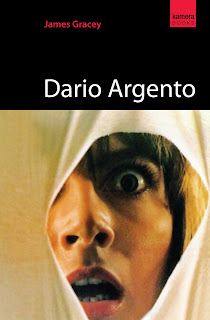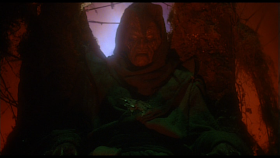
Directed by
Giulio PetroniStarring
Luke Askew ("Luke"),
Luigi Pistilli ("Lieutenant Hernandez"),
Magda Konopka, and
Chelo AlonsoRunning time: 01:41:02
Country: Italy
Admittedly, I've only seen one other film by director Giulio Petroni prior to watching this, but it was a great one nonetheless. That film was the excellent
DEATH RIDES A HORSE, which is easily one of my favorite Spaghetti Westerns. Petroni only has a little over a dozen directorial credits to his filmography, most of which are pretty obscure. It seems he dabbled in various genres, but I think it's safe to say - based on the research I've done on him - that he'll be remembered for his Westerns. While not as good as the DEATH RIDES A HORSE, which featured John Phillip Law as a man driven to avenge the death of his family, NIGHT OF THE SERPENT is still pretty good and hits a lot of the same beats as DEATH RIDES.
American actor Luke Askew, whose character in the film is also named "Luke", plays an alcoholic and the sole Gringo amidst a group of Mexicans who mistreat and abuse him. For a number of reasons that I'll eventually touch on in this review, I had a hard time figuring out exactly what Luke's status was and why he was this out-of-place blonde-haired American who seemed to co-exist with a bunch of loudmouthed Mexicans. I assumed he had nowhere to go and he was simply doing what he had to do to survive and earn enough money (or tequila) to get by and live his miserable life. Whatever the case, Luke is hired by a corrupt Federale, Lieutenant Hernandez, to basically be the sacrificial lamb in a plot to kill someone and gain their inheritance money, but when Luke realizes he was sent to kill a child, he kicks the booze and essentially gets his groove back so that he can protect the kid.

I don't know if it was the script or the lackluster audio quality of the copy I watched, but I found it difficult to keep track of what was going on at times and make sense of everything. Had I known that the film would reveal certain clues about the plot as the film progressed, I wouldn't have gone back and watched the same couple of scenes six or seven times to see if I missed anything. The whole inheritance thing in particular was a bit confusing because of how Lt. Hernandez orchestrated it. Basically, he was able to blackmail a couple of people who accidentally killed a telegraphist who was sent from out of town to deliver a message regarding the boy's inheritance. Hernandez finds out about this and swiftly gathers the two men responsible for the telegraphist's death, but then there are two other people involved who, initially, didn't seem to have anything to do with the murder. It's then revealed that they're all entitled to the boy's inheritance since they're apparently his relatives, but even by the time the movie was over it still didn't make much sense.

Even though the quality of the print that was presented here wasn't exactly great, you could still see a really bad makeup job on one of the actors. In certain Westerns, actors' faces were basically painted brown to give them the appearance of a Mexican who had been out in the sun for way too long, and most films do a good enough job of making it look as subtle as possible, but in this film there's an actor who's obviously wearing a distracting and unnatural shade of brown makeup that stands out compared to the rest of his body's complexion. I can only imagine how this would look if NIGHT OF THE SERPENT were to be properly rescued from obscurity and given the HD treatment. Thankfully, the lazy makeup job was not a reflection of the rest of the film's quality.

The only major setback of this film, in my opinion, is how confusingly it tells its story, which I touched on earlier. Other than that, NIGHT OF THE SERPENT is quite enjoyable despite not standing out from other Spaghetti Westerns in a major way. As I said earlier, it hits some of the same beats as DEATH RIDES A HORSE (and many other Westerns for that matter) in terms of the narrative and the characters. It's shot fairly well, it's scored amazingly by
Riz Ortolani, and the character are well-developed in that the antagonists are appropriately evil and the protagonists are easy to get behind. The character of Luke in particular is great because of how he's established throughout the film, and it's one of the cases where information is gradually revealed in a way that doesn't spell everything out for you at first and it's done right. When he's first recruited by Lt. Hernandez and is given a gun, Luke's mind begins to drift, at which point the film cuts to what looks like a brief dream sequence where he's imagining himself as a handsome cowboy who's quite handy with a pistol (later scenes of him shooting at targets would contradict that), but when these sequences begin to pop up on a frequent basis throughout the film, it becomes evident that these are in fact flashback scenes showing you what Luke was like before his life seemingly went to shit and explaining
why he ended up in the gutter. Not to spoil anything, but the final flashback pays off in a big way and explains so much about Luke.

The relationship between Luke and the boy doesn't become a "thing" that takes away from the plot or Luke's character development, which I liked. The boy is more or less a catalyst for Luke to pull himself out of the gutter and, in a way, face the demons that have apparently been haunting him for many years. However, the best thing about their relationship in my opinion is that it introduces the boy's mother, played by Magda Konopka, who is absolutely mesmerizing. NIGHT OF THE SERPENT is mostly noteworthy for being a rare and obscure Spaghetti Western that was sought after by enthusiasts of the genre for many years, but it's a pretty good film to boot for reasons that I already talked about. This is obviously not a starting point for anyone looking to get into Westerns, but at the same time it can still be enjoyed as a standalone movie by people who aren't necessarily into Westerns because of the fact that it's fairly accessible, and those who are already fans of the genre should get some satisfaction out of it. Besides, you can't really go wrong with the great Luigi Pistilli playing a heavy.

Make or Break: Luke's introduction.
MVT: Riz Ortolani's score. One of the best Spaghetti Western scores I've ever heard, which says a lot considering there are some truly masterful pieces of music associated with these types of films. At times the music is sinister and Giallo-esque for lack of a better term, and at other times the music evokes images of a European Gothic Horror film because of Ortolani's use of organs in the soundtrack. My favorite piece of music is what I assume was intended to be Luke's theme song, which consists of some very somber-sounding acoustic guitars highlighted by tribal percussion. Gorgeous stuff overall.
Score: 7/10


The Disc: DVD rip, cropped widescreen, English language with no subtitles. Apparently it was extremely hard to get a copy of this film with its English audio track for many years until some South African company released a version of it, which I assume is the same version that Cinema de Bizarre is providing, albeit a ripped copy. NIGHT OF THE SERPENT, like most Spaghetti Westerns, was shot in 2.35:1 aspect ratio, and the black bars at the top and bottom of the screen are still in tact on this copy, but instead of just being modified to full-screen and retaining all of the picture, it's blown up with the sides of the picture cut out, which you can see on the accompanying screenshot. Not a big deal since you're not missing any of the action and most of the shots of the actors are pretty tight anyway, but it's noticeable at times. The video quality is decent and watchable - not much better or worse than most copies you'll find of obscure Spaghetti Westerns. The audio, on the other hand, is a bit of a problem. The sound is nice and loud, but the audio is a bit fuzzy at times and not very clear when certain people are speaking. It's comparable to listening to the film through a stereo with blown-out speakers. All of that being said, this is still the best version of the film out there, so it is what it is.
Links:
Cinema de BizarreNIGHT OF THE SERPENT on Cinema de BizarreGGTMC's Review of DEATH RIDES A HORSEBe sure to use the promo code GENTLEMEN for 10% off your orders!










































